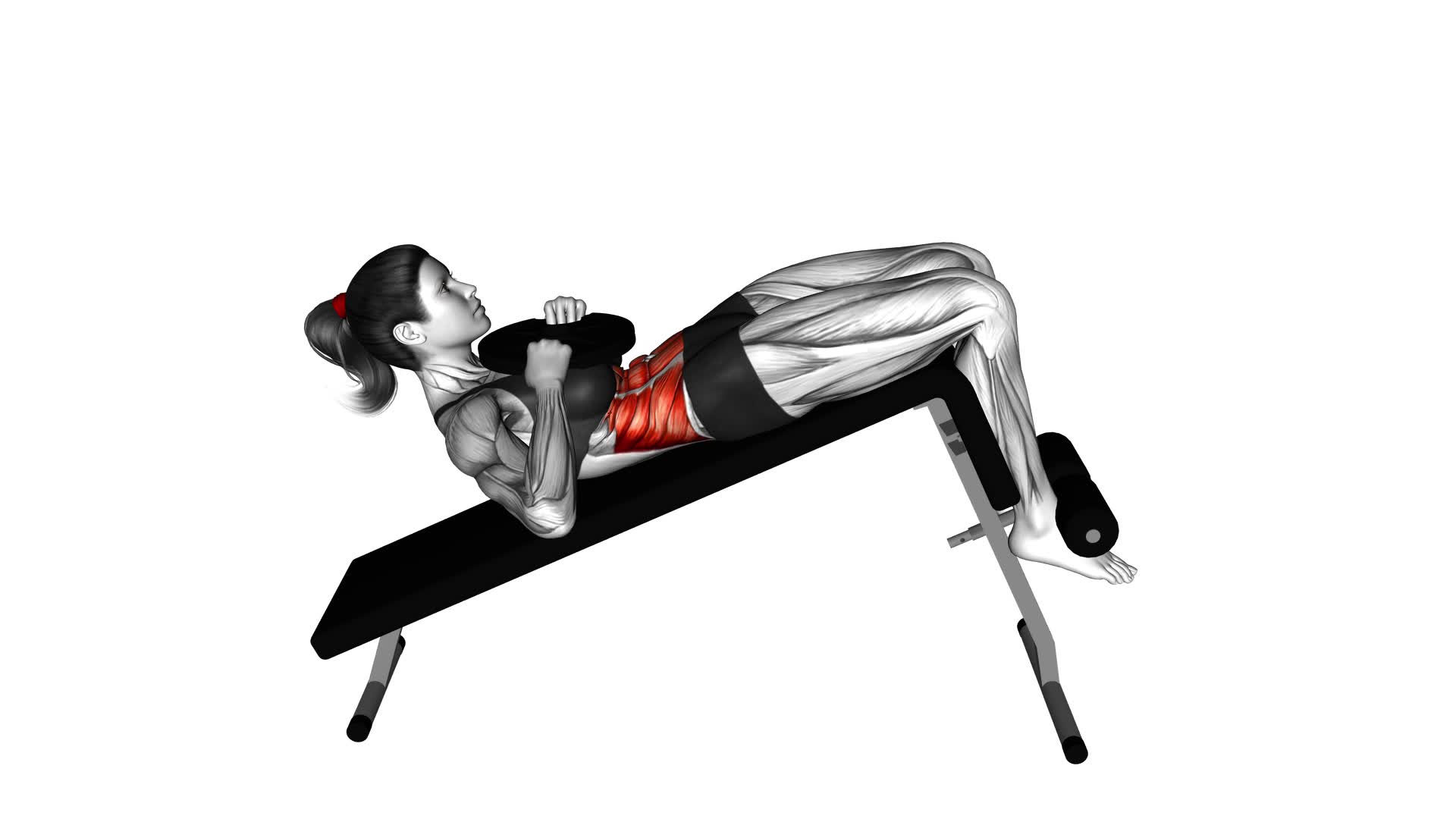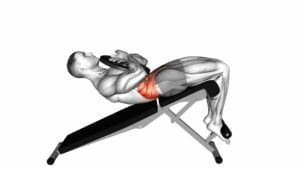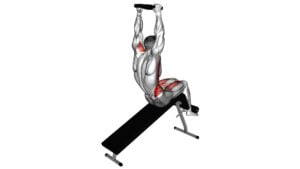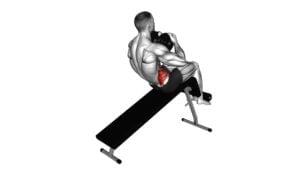Weighted Decline Crunch (female) – Video Exercise Guide & Tips

Looking to strengthen your core and tone your abs? Check out this video exercise guide for the weighted decline crunch!
Watch This Exercise Video
In this workout, you'll learn how to properly perform the exercise, the equipment you'll need, and tips for maintaining proper form.
Plus, we'll show you variations to challenge and progress your routine.
Get ready to feel the burn and achieve your fitness goals with the weighted decline crunch!
Key Takeaways
- Strengthens and defines the core
- Improves overall fitness and posture
- Helps stabilize the body and prevent injuries
- Targets abdominal muscles including rectus abdominis, obliques, and transverse abdominis
Benefits of the Weighted Decline Crunch
You can achieve a stronger and more defined core by incorporating the weighted decline crunch into your workout routine. Core strength is essential for overall fitness as it plays a crucial role in stabilizing your body, improving posture, and preventing injuries. The weighted decline crunch specifically targets your abdominal muscles, including the rectus abdominis, obliques, and transverse abdominis.
To incorporate the weighted decline crunch into your full body workout routine, start by adjusting the decline bench to a comfortable angle. Lie down on the bench with your feet secured, holding a dumbbell or a weight plate against your chest. Engage your core and slowly lift your upper body towards your knees, focusing on contracting your abdominal muscles. Pause for a moment at the top of the movement, then lower yourself back down with control.
To make the exercise more challenging, you can increase the weight or perform the crunch on an unstable surface, such as a stability ball. Remember to maintain proper form throughout the exercise and avoid using momentum to lift your body. Aim for 2-3 sets of 10-15 repetitions, gradually increasing the weight and intensity as your core strength improves.
Incorporating the weighted decline crunch into your workout routine can help you develop a stronger and more defined core, contributing to your overall fitness and well-being.
Equipment Needed for the Exercise
To effectively perform the weighted decline crunch exercise, it's important to have the necessary equipment. Here are the items you'll need:
- Weighted decline bench: This specialized bench is designed to provide stability and support during the exercise. It has an adjustable decline angle that targets your abdominal muscles more effectively than a flat bench.
- Ankle weights: Adding ankle weights to your workout can increase the resistance and intensity of the exercise. These weights strap around your ankles and provide an extra challenge for your core muscles.
- Dumbbells: While not mandatory, using dumbbells can further enhance the effectiveness of the exercise. Holding dumbbells against your chest during the decline crunch adds extra resistance, helping to strengthen your abdominal muscles.
- Exercise mat: A comfortable and supportive exercise mat provides cushioning for your back and reduces the risk of discomfort or injury.
- Water bottle and towel: Staying hydrated during your workout is crucial. Keep a water bottle nearby to sip on between sets. Additionally, a towel can be handy for wiping away sweat and maintaining hygiene.
Having the proper equipment ensures that you can perform the weighted decline crunch safely and effectively. Remember to consult with a fitness professional or trainer before attempting any new exercise.
Step-By-Step Guide on How to Perform the Weighted Decline Crunch
To begin performing the weighted decline crunch, position yourself on the weighted decline bench. Lie down on the bench with your feet secured under the foot pads and your knees bent at a 90-degree angle. Hold a dumbbell or weight plate against your chest with both hands to add resistance to the exercise.
Engage your core muscles by pulling your navel towards your spine, and then slowly lift your upper body off the bench, using your abdominal muscles. As you curl your body upwards, exhale and squeeze your abs. Pause briefly at the top of the movement to fully contract your abdominal muscles.
To avoid common mistakes, make sure to keep your neck relaxed and avoid pulling on it with your hands. Also, be mindful not to use momentum or swing your body to complete the exercise. Instead, focus on using your abdominal muscles to control the movement.
If you're looking for modifications or alternatives, you can perform the decline crunch without any weights if you're a beginner or have difficulty with the added resistance. Additionally, you can try different variations such as twisting your torso to target oblique muscles or holding the weight plate above your head for an increased challenge.
Remember to always consult with a qualified fitness professional before attempting any new exercises, especially if you have any underlying health conditions or injuries.
Tips for Maintaining Proper Form and Technique
Maintain proper form and technique by focusing on engaging your core muscles and controlling the movement throughout the weighted decline crunch exercise. Here are some tips to help you maintain proper form and technique:
- Avoid using momentum: It's important to avoid swinging or using momentum to lift the weight. Instead, focus on using your abdominal muscles to lift your upper body and engage your core throughout the movement.
- Keep your neck relaxed: Many people tend to strain their necks during crunches. To avoid this, keep your neck relaxed and focus on using your abs to lift your upper body.
- Breathe properly: Remember to exhale as you lift your upper body and inhale as you return to the starting position. Proper breathing technique will help you engage your core muscles more effectively.
- Start with a manageable weight: When performing weighted decline crunches, it's important to start with a weight that challenges you but is still manageable. Choose a weight that allows you to complete the exercise with proper form and technique.
- Avoid arching your back: Arching your back during the exercise puts unnecessary strain on your lower back. Keep your back flat against the bench and focus on using your abs to lift your upper body.
Variations to Challenge and Progress Your Workout
Challenge and progress your workout with these variations of the weighted decline crunch exercise.
To take your core strengthening exercises to the next level, try incorporating advanced modifications into your routine. One option is to perform the weighted decline crunch with an added twist. Start by lying on the decline bench with a weight plate held against your chest. As you crunch up, rotate your torso to one side, bringing your opposite elbow towards the opposite knee. This movement engages your obliques and adds an extra challenge to your workout.
Another variation is the weighted decline crunch with a leg raise. Begin in the same position as the standard exercise, but as you crunch up, simultaneously lift your legs off the ground and bring your knees towards your chest. This variation not only targets your abs but also activates your hip flexors and lower abdominal muscles.
Incorporating these advanced modifications into your routine will help you continue challenging and progressing your core strength workouts.
Frequently Asked Questions
How Many Calories Does the Weighted Decline Crunch Burn?
The weighted decline crunch can help you burn calories and increase your caloric expenditure. It's a great exercise for targeting your abdominal muscles and strengthening your core.
However, the exact number of calories burned during a weighted decline crunch can vary based on factors such as your body weight, intensity, and duration of the exercise.
If you're looking for alternative exercises to burn calories, you might consider high-intensity interval training (HIIT) workouts or aerobic exercises like running or cycling.
Can the Weighted Decline Crunch Help Reduce Belly Fat?
The weighted decline crunch can be effective in reducing belly fat. By adding resistance with weights, it increases the intensity of the exercise and targets the abdominal muscles more effectively.
It also engages the lower abs, helping to tone and strengthen the entire core. To get the most out of this exercise, make sure to use proper form and maintain a controlled movement throughout.
There are also variations of the weighted decline crunch that you can incorporate into your routine for added challenge and variety.
Is the Weighted Decline Crunch Suitable for Beginners?
The weighted decline crunch is suitable for beginners as it provides variations to accommodate different fitness levels. It's a beneficial exercise that targets the abdominal muscles, helping to strengthen and tone them.
By adding weights, you can increase the intensity and challenge yourself as you progress. Remember to start with lighter weights and focus on proper form to avoid injury.
As you become more comfortable, you can gradually increase the weights for greater results.
Can the Weighted Decline Crunch Be Modified for Individuals With Lower Back Pain?
If you have lower back pain, you may need to modify the weighted decline crunch exercise. There are alternative exercises that can target your abdominal muscles without putting strain on your lower back.
It's important to consult with a fitness professional or physical therapist to find the best exercises for your specific condition. They can provide guidance on modifications and recommend exercises that will help strengthen your core while minimizing discomfort in your lower back.
How Often Should the Weighted Decline Crunch Be Performed for Optimal Results?
To get optimal results from the weighted decline crunch, it's important to perform it regularly. The exercise is great for strengthening your core muscles, which can improve your overall stability and posture.
For best results, aim to do the weighted decline crunch at least two to three times a week.
If you're an advanced trainer looking for variations, you can try adding different types of weights or incorporating twists to target different parts of your core.
Conclusion
In conclusion, the weighted decline crunch is a highly effective exercise for targeting the abdominal muscles. It offers numerous benefits, including increased core strength and stability.
With the right equipment and proper form, this exercise can be easily incorporated into your workout routine. Remember to focus on maintaining proper technique and consider adding variations to challenge yourself and continue progressing.
Incorporate the weighted decline crunch into your fitness regimen to achieve a stronger and more defined core.

Author
Years ago, the spark of my life’s passion ignited in my mind the moment I stepped into the local gym for the first time. The inaugural bead of perspiration, the initial endeavor, the very first surge of endorphins, and a sense of pride that washed over me post-workout marked the beginning of my deep-seated interest in strength sports, fitness, and sports nutrition. This very curiosity blossomed rapidly into a profound fascination, propelling me to earn a Master’s degree in Physical Education from the Academy of Physical Education in Krakow, followed by a Sports Manager diploma from the Jagiellonian University. My journey of growth led me to gain more specialized qualifications, such as being a certified personal trainer with a focus on sports dietetics, a lifeguard, and an instructor for wellness and corrective gymnastics. Theoretical knowledge paired seamlessly with practical experience, reinforcing my belief that the transformation of individuals under my guidance was also a reflection of my personal growth. This belief holds true even today. Each day, I strive to push the boundaries and explore new realms. These realms gently elevate me to greater heights. The unique combination of passion for my field and the continuous quest for growth fuels my drive to break new ground.







